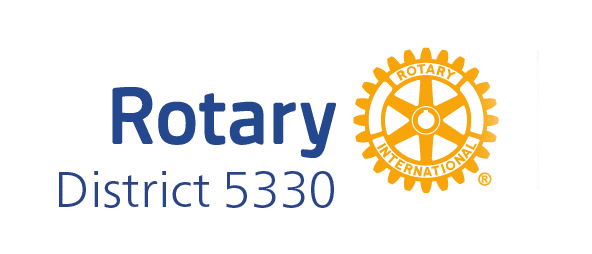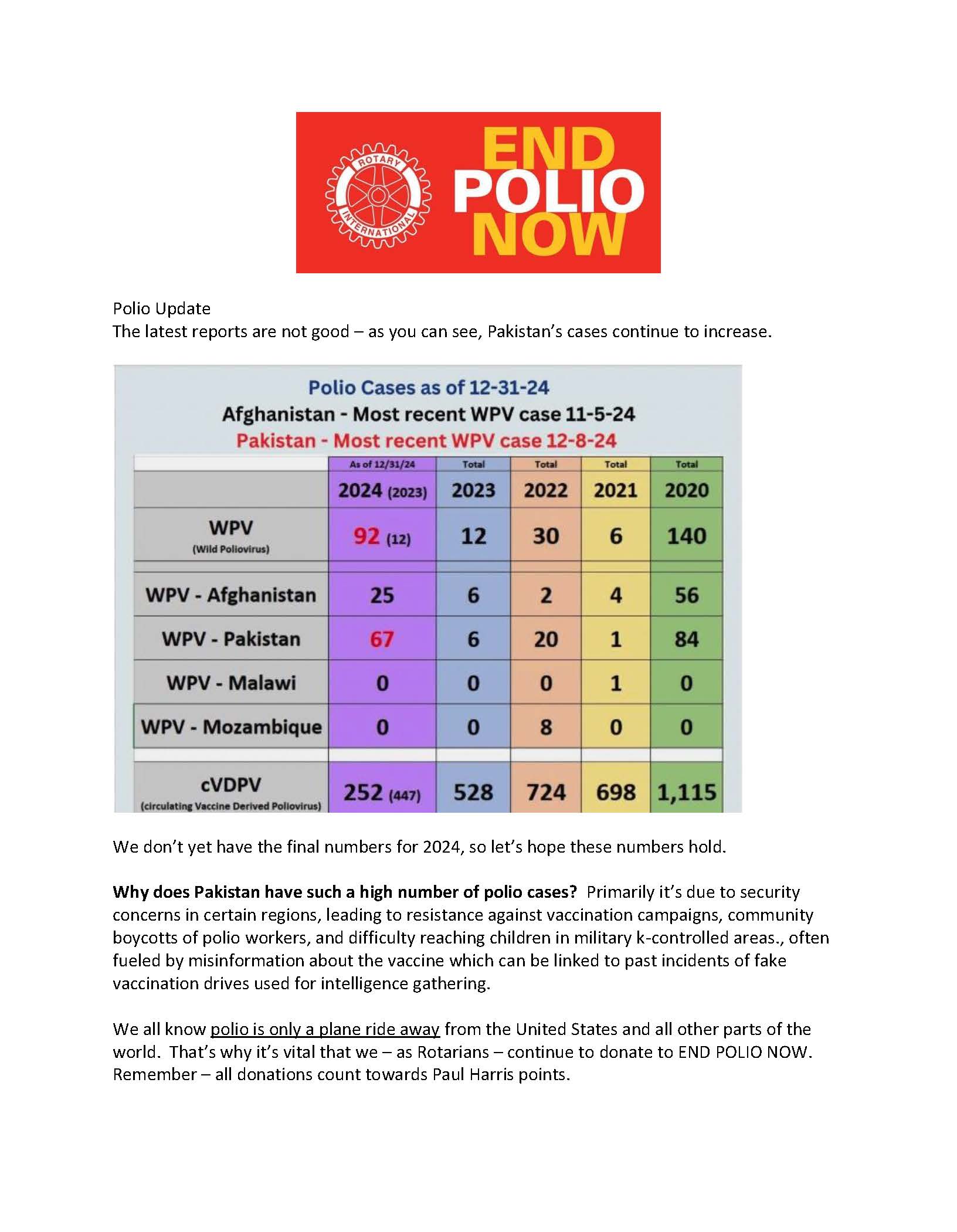LITERACY
ROTARY MAKES HELP HAPPEN

Rotary Global Grant – Dominican Republic Project Trip
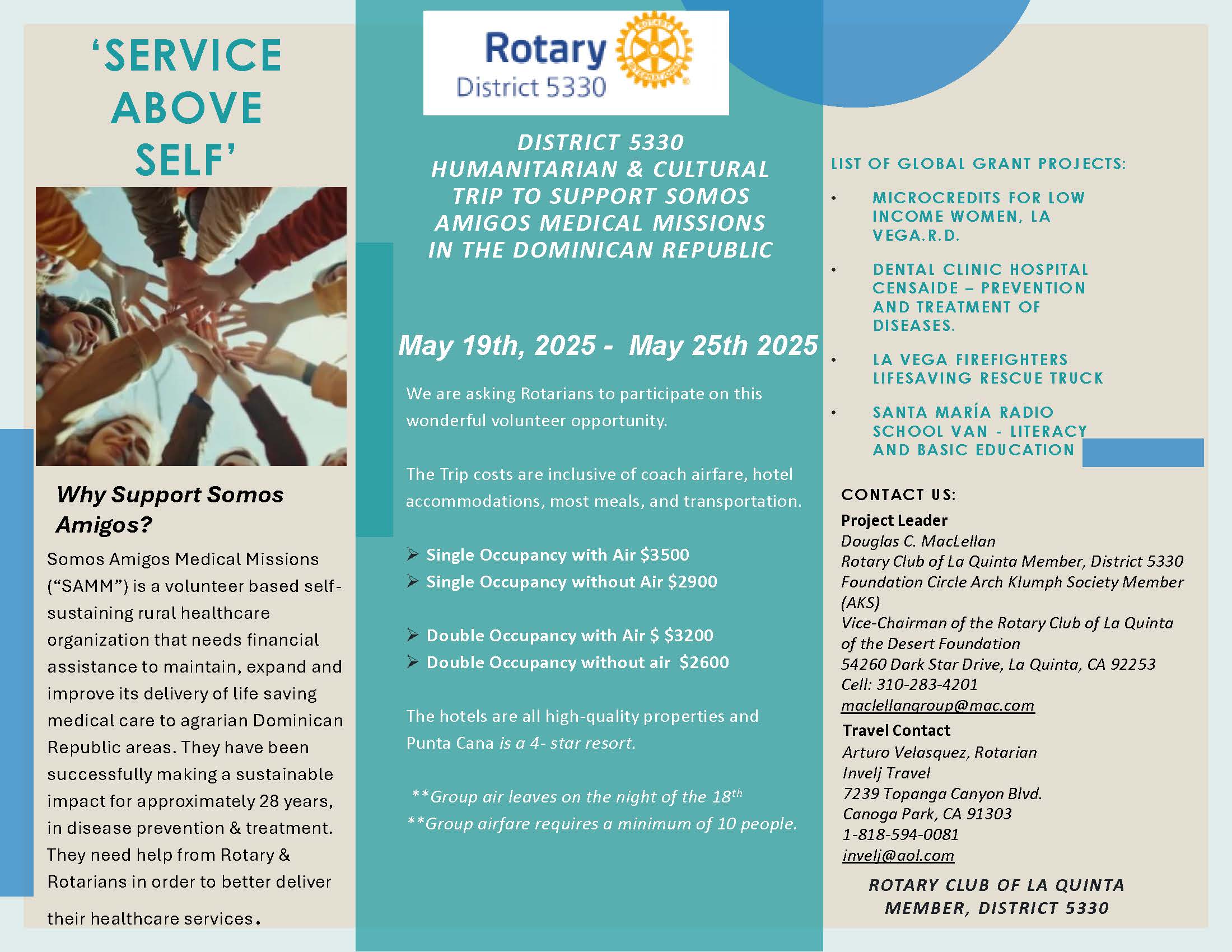
February 2025 – Community Service
Limiting Vulnerability With Community Service
With the recent fires here in SoCal it is pretty evident that disasters for some create opportunities.
Every club in our district has specific areas that are both very susceptible to fires when things get dry, as well as elderly that are unable to physically or financially attack the necessary abatement that their property desperately needs.
What a great opportunity clubs have to create a new category of community service on a monthly ongoing basis.
Helping to assist or handle abatement against fires is something that only takes a group of people once a month to make a huge difference. Just think if our clubs had two groups : a “weekend abatement” and “weekday abatement” group to attack much needed help in our communities. Many fire departments can let us know areas that we can go out and perform fire abatement getting rid of dead undergrowth, weeds and the like in our communities. As a matter of fact, some fire departments will work with groups that contact them asking for locations the club can help abate.
Low income areas with senior citizens that are not physically able to perform or pay to to abate are great targets for assistance. Senior centers are a great place to ask around as are mobile home parks. It’s amazing what can be done and who can be helped in advance of a catastrophe that can make a huge difference and even impact saving lives. Many clubs have retirees that can form a phone chain to get out there and help during the work week and all clubs have professionals that can help one weekend a month being set up via another phone chain. We all know that working together with our fellow members is a strong glue that makes our clubs and friendships stronger. Why not create “Pizza and Pick Weeds” events? (What members can turn down a pizza?)
We are Rotary, let’s help get ahead of issues whenever we can: it’s fun, it’s productive and our visual appearance out in the community is a great way to also attract and recruit new members.
Chuck Weisbart (Cheeze)
Proudly- an Idyllwild Rotarian!
D5330 Community Service Chair
760 578 3592
P.O.Box 278, Idyllwild CA 92549
February 2025 – Vocational Service
Happy New Year to all the Rotarians in D5330! The past 6 months have flown by! Now we are coming down to the last 5 months of this Rotary year and DGE Nyron’s Pre-PETS and DG Judy’s Mid-Year Review were tremendously successful last month! Both were held at Crafton Hills College on January 18th. Much was learned by all of the participants.
Now it’s time to focus on the upcoming District Training Assembly on Saturday, April 19th again at Tahquitz HS in Hemet. I will be conducting a session on the 5 Avenues of Service with emphasis, of course, on Vocational Service. There will be others speaking specifically on International and Community Service, as well. Please join us!
As I have mentioned in previous articles here on the district’s blog, I would love for all of the clubs in the district to nominate an Outstanding Business or Profession that has greatly benefitted your community this past Rotary year. The Rotary Award for Vocational Excellence (R.A.V.E.) will be given out at DG Judy’s District Conference in May. The deadline for your submission is March 15. The application is in this blog. While you complete the form, please detail how your nominee has benefitted your immediate community. I would like you to be as informative as possible about your nominee when filling out the form. My e-mail to send it back to me is: [email protected]
I look forward to receiving your completed applications before the deadline date so our committee may evaluate each and every one of the nominees.
Thank you and Good Luck!
Bill Chase, PDG
Chair, D5330 Vocational Service Committee
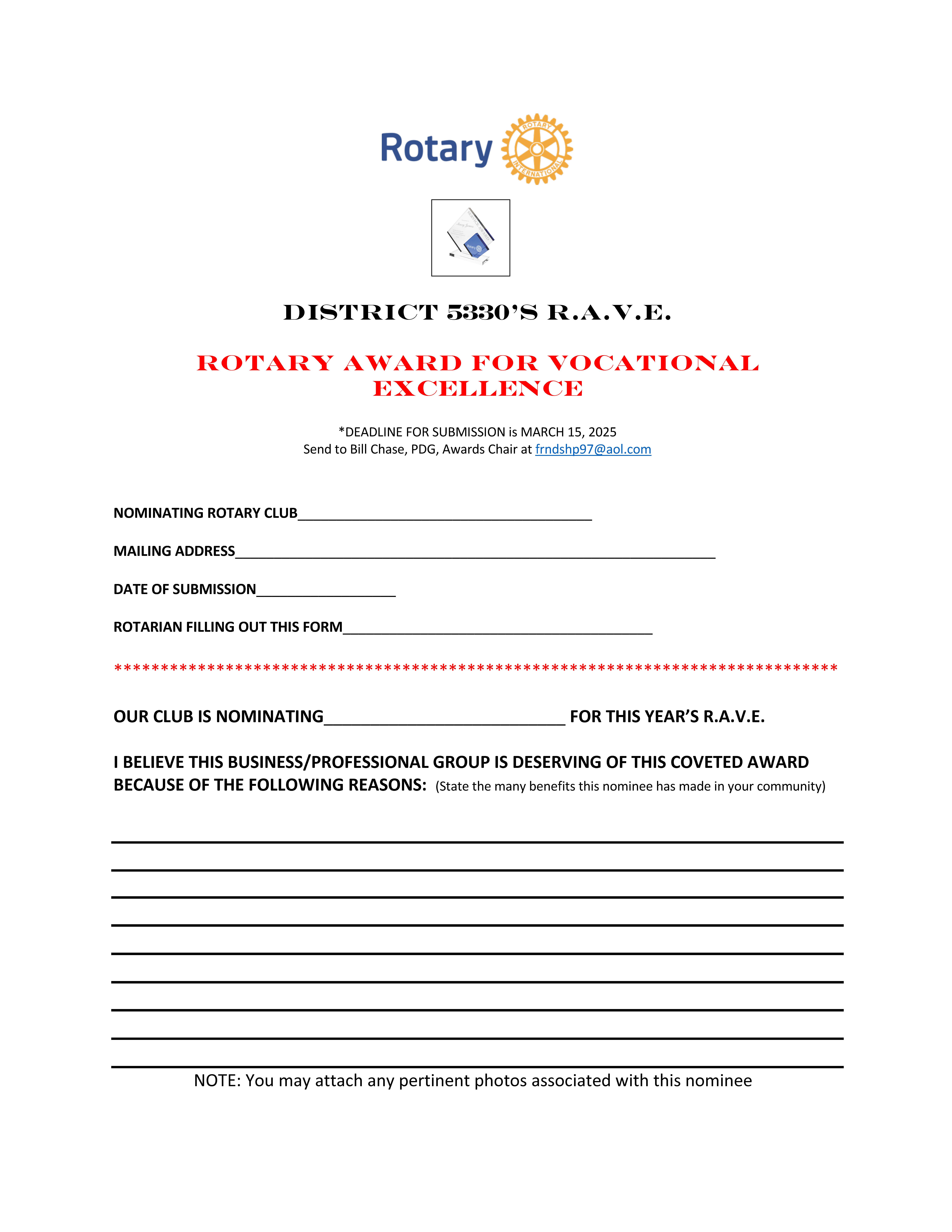
February – 4 Way Test Speech Contest
February 2025 – Corona Golf Tournament
Pollinators: The Little Things That Move the World
Jack Fitzsimmons
Rotary Club of Palm Desert
“Do you like to eat?”
Ask that question of a classroom full of third graders and you can imagine the response! I ask a second question: “Do you like to eat apples, or pumpkin pie, or watermelon?” Enthusiastic hands shoot up in the air. And then a final question, “Who helped make that apple that you eat?” Shouted responses include “Mommy! Abuela! Albertson’s!” You can hear a pin drop when I say, “That apple actually starts with a bee!” Thus begins the students first introduction to pollination.
So, what on earth does pollination have to do with Rotary? Quite a lot, it turns out.
On June 25, 2020, Rotary President Mark Maloney announced Protecting the Environment as our Seventh Area of Focus. Of course, Rotarians have been involved for decades with projects involving the environment. It many cases, the health of the environment is inseparable from issues of maternal health, water and hygiene, community building, and increasingly, peacebuilding. According to a World Bank estimates, by 2050 as many as 216 million people could be internally displaced by climate change. Tragically, the impact of a changing climate, compounded by habitat loss, pesticide misuse, and plant disease, is hitting our pollinators. Hard. Decline in pollinators varies according to species, but losses have exceeded 40% in the last decade – with no end in sight.
Consider the apple again. Most people are not aware that one out of every three bites of food we eat depend on pollinators. Some crops, like almonds, are entirely dependent on pollinators. In fact, 85% of the plants on Mother Earth depend on pollinators. With our food security facing an existential crisis of such magnitude, what can we do? Plenty!
People of Action Step Up
The first Operation Pollination (OP) project was launched in August 2015 in the St. Croix Valley of Minnesota and Wisconsin. A group of concerned citizens organized to collectively address the issue of pollinator loss and began restoring and creating pollinator habitats in their backyards, city parks, and schoolyards.
The organization blossomed and on September 24, 2022, the Environmental Sustainability Rotary Action Group (ESRAG), a division of Rotary International, and its Pollinator Task Group organized the signing of a multitude of pollinator partnership resolutions between Rotary districts and National Heritage Areas and other partners throughout the US, Canada and Mexico. This historic signing was done in coordination with the whistle-stop campaign of Rotary International’s first female president, Jennifer Jones.
Today, OP has 253 signed Pollinator Resolutions with Rotary Districts, individual clubs, water agencies, municipalities, and non-profit organizations. There are currently 175 OP “ambassadors” on six continents who have been trained to act as a catalyst for engagement and education. I have the great fortune to be one of the most recent ambassadors.
On December 27, 2024, District 5330 Governor Judy Zulfiqar signed the Pollinator Resolution. The Resolution is simple: it acknowledges the critical importance of pollinators and the crisis that we are facing, and that the leadership and impact of Rotarians volunteering to improve communities is a hallmark of Rotary International.
It is important to note that ESRAG’s Operation Pollination is a truly inclusive framework that helps recruit a diverse array of organizational partners willing to engage in the framework’s two goals: pollinator habitat restoration and education projects. Anyone can join; you do not have to be a Rotarian.
Personal Action
You can help pollinators at a personal level by a few simple steps:
- Plant a pollinator garden in your window box, patio, or backyard. Use native plants as much as possible because some pollinators won’t visit the “foreign” exotics that you find in nursery centers and big box stores, leading to a further loss of pollen and nectar food for local species.
- Provide nesting materials such as a small pile of brush or a hollow bamboo or yucca stem. Provide a shallow dish of water and most importantly, leave some of the soil of your yard or potted plants bare. Many of the local pollinator species nest in the ground.
- Eliminate the use of pesticides wherever possible since they poison both harmful and beneficial insects – and us!
- Learn about and get involved with the many like-minded organizations in your area – garden clubs, butterfly networks, native plant societies, and botanical and demonstration gardens.
- Buy organic produce from small local farms who use sustainable pollinator practices.
Club Action
On their websites, ESRAG and Operation Pollination offer a comprehensive Project Planning Toolkit and numerous examples of pollinator projects. These can range from establishing a pollinator demonstration at a local grade school, church or assisted living facility and sponsoring native plant sales and seed swaps, to advocating for open space and responsible land management at local government agencies. At a larger scale, there have been District and multi-district efforts to create pollinator garden “pathways” across state and country borders to support Monarch butterfly migration. And in Europe, there is a four-country project that gave away flowering plants to improve declining honey production. The project even collected and sold honey to enable the project’s sustainability. Large or small, there is nothing that People of Action cannot accomplish.
Want to know more?
Watch this short video produced by Operation Pollination and this interview with Past President Jennifer Jones. You can always contact me at [email protected] if for further information about Operation Pollination.

February 2025 – Palm Desert
Pollinators: The Little Things That Move the World
Jack Fitzsimmons
Rotary Club of Palm Desert
“Do you like to eat?”
Ask that question of a classroom full of third graders and you can imagine the response! I ask a second question: “Do you like to eat apples, or pumpkin pie, or watermelon?” Enthusiastic hands shoot up in the air. And then a final question, “Who helped make that apple that you eat?” Shouted responses include “Mommy! Abuela! Albertson’s!” You can hear a pin drop when I say, “That apple actually starts with a bee!” Thus begins the students first introduction to pollination.
So, what on earth does pollination have to do with Rotary? Quite a lot, it turns out.
On June 25, 2020, Rotary President Mark Maloney announced Protecting the Environment as our Seventh Area of Focus. Of course, Rotarians have been involved for decades with projects involving the environment. It many cases, the health of the environment is inseparable from issues of maternal health, water and hygiene, community building, and increasingly, peacebuilding. According to a World Bank estimates, by 2050 as many as 216 million people could be internally displaced by climate change. Tragically, the impact of a changing climate, compounded by habitat loss, pesticide misuse, and plant disease, is hitting our pollinators. Hard. Decline in pollinators varies according to species, but losses have exceeded 40% in the last decade – with no end in sight.
Consider the apple again. Most people are not aware that one out of every three bites of food we eat depend on pollinators. Some crops, like almonds, are entirely dependent on pollinators. In fact, 85% of the plants on Mother Earth depend on pollinators. With our food security facing an existential crisis of such magnitude, what can we do? Plenty!
People of Action Step Up
The first Operation Pollination (OP) project was launched in August 2015 in the St. Croix Valley of Minnesota and Wisconsin. A group of concerned citizens organized to collectively address the issue of pollinator loss and began restoring and creating pollinator habitats in their backyards, city parks, and schoolyards.
The organization blossomed and on September 24, 2022, the Environmental Sustainability Rotary Action Group (ESRAG), a division of Rotary International, and its Pollinator Task Group organized the signing of a multitude of pollinator partnership resolutions between Rotary districts and National Heritage Areas and other partners throughout the US, Canada and Mexico. This historic signing was done in coordination with the whistle-stop campaign of Rotary International’s first female president, Jennifer Jones.
Today, OP has 253 signed Pollinator Resolutions with Rotary Districts, individual clubs, water agencies, municipalities, and non-profit organizations. There are currently 175 OP “ambassadors” on six continents who have been trained to act as a catalyst for engagement and education. I have the great fortune to be one of the most recent ambassadors.
On December 27, 2024, District 5330 Governor Judy Zulfiqar signed the Pollinator Resolution. The Resolution is simple: it acknowledges the critical importance of pollinators and the crisis that we are facing, and that the leadership and impact of Rotarians volunteering to improve communities is a hallmark of Rotary International.
It is important to note that ESRAG’s Operation Pollination is a truly inclusive framework that helps recruit a diverse array of organizational partners willing to engage in the framework’s two goals: pollinator habitat restoration and education projects. Anyone can join; you do not have to be a Rotarian.
Personal Action
You can help pollinators at a personal level by a few simple steps:
- Plant a pollinator garden in your window box, patio, or backyard. Use native plants as much as possible because some pollinators won’t visit the “foreign” exotics that you find in nursery centers and big box stores, leading to a further loss of pollen and nectar food for local species.
- Provide nesting materials such as a small pile of brush or a hollow bamboo or yucca stem. Provide a shallow dish of water and most importantly, leave some of the soil of your yard or potted plants bare. Many of the local pollinator species nest in the ground.
- Eliminate the use of pesticides wherever possible since they poison both harmful and beneficial insects – and us!
- Learn about and get involved with the many like-minded organizations in your area – garden clubs, butterfly networks, native plant societies, and botanical and demonstration gardens.
- Buy organic produce from small local farms who use sustainable pollinator practices.
Club Action
On their websites, ESRAG and Operation Pollination offer a comprehensive Project Planning Toolkit and numerous examples of pollinator projects. These can range from establishing a pollinator demonstration at a local grade school, church or assisted living facility and sponsoring native plant sales and seed swaps, to advocating for open space and responsible land management at local government agencies. At a larger scale, there have been District and multi-district efforts to create pollinator garden “pathways” across state and country borders to support Monarch butterfly migration. And in Europe, there is a four-country project that gave away flowering plants to improve declining honey production. The project even collected and sold honey to enable the project’s sustainability. Large or small, there is nothing that People of Action cannot accomplish.
Want to know more?
Watch this short video produced by Operation Pollination and this interview with Past President Jennifer Jones. You can always contact me at [email protected] if for further information about Operation Pollination.

February 2025 – Polio Plus
2025 February – DEI
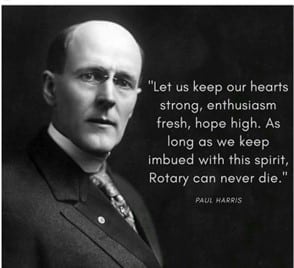
THE PAUL HARRIS WAY
Classifications. Remember those? Virtually all membership in Rotary was based upon a “classification” that described the distinct and recognized business or professional service that the Rotarian renders to society. Rotary International ended required classification designations a few years ago, and many clubs no longer require that either.
How diverse are the business classifications in your club? Does your Rotary club represent a cross section of the business and professional service of your community. Does your club have a member directory identifying members’ businesses so that members can patronize them?
Diversity is also about recognizing, respecting and valuing differences in our members and in our communities.
Setting aside the divisive discussions on diversity, consider it in the context of business classifications and how a wide variety of classifications benefits your club. Paul Harris found Rotary on the premise that Diversity is also about recognizing, respecting and valuing differences based on people of good will and diverse backgrounds should come together in the spirit of friendship to foster better understanding. He believed that clubs should represent and embrace the diversity in their communities.
January 2025 – Club Event Temecula Sunrise
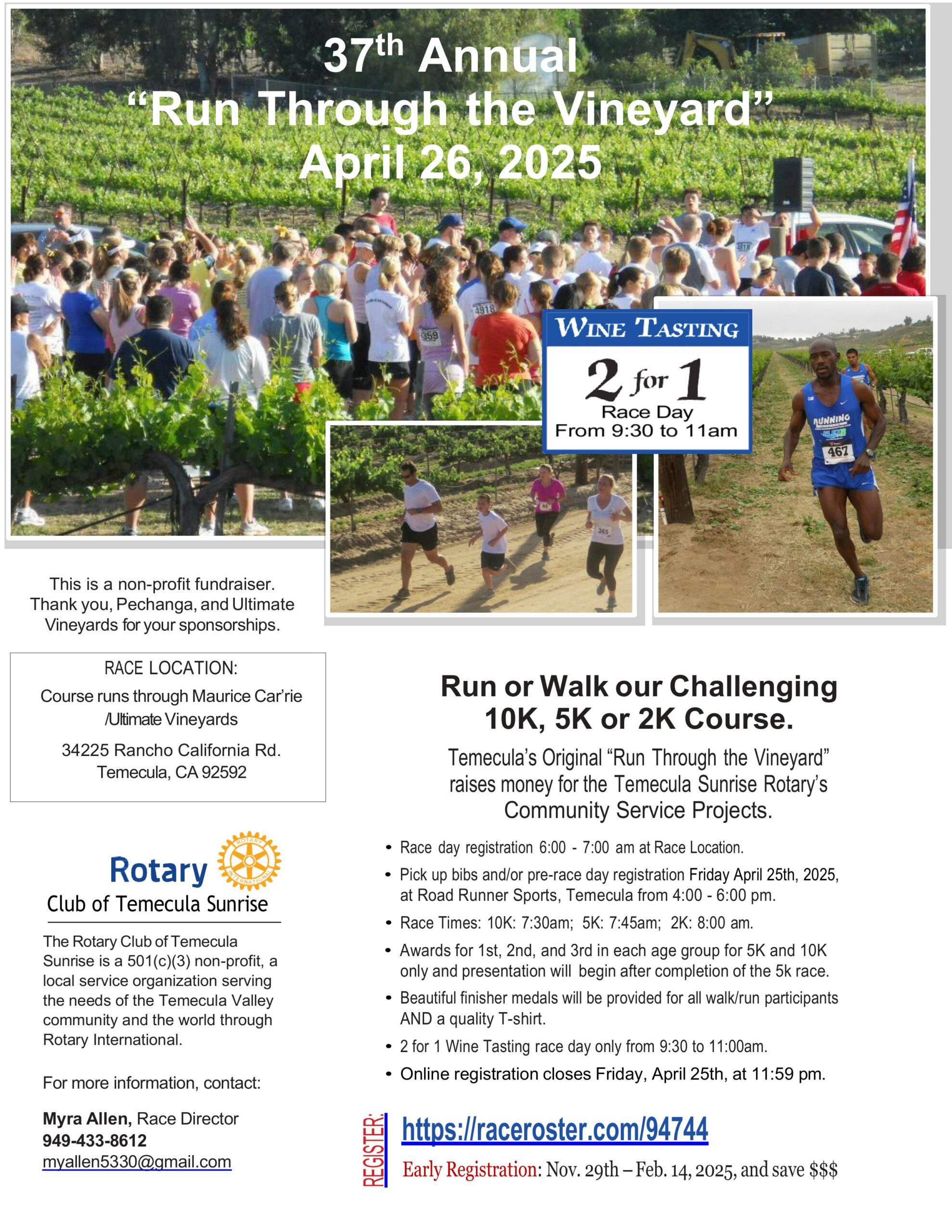
January 2025 – 4 Way Speech Test
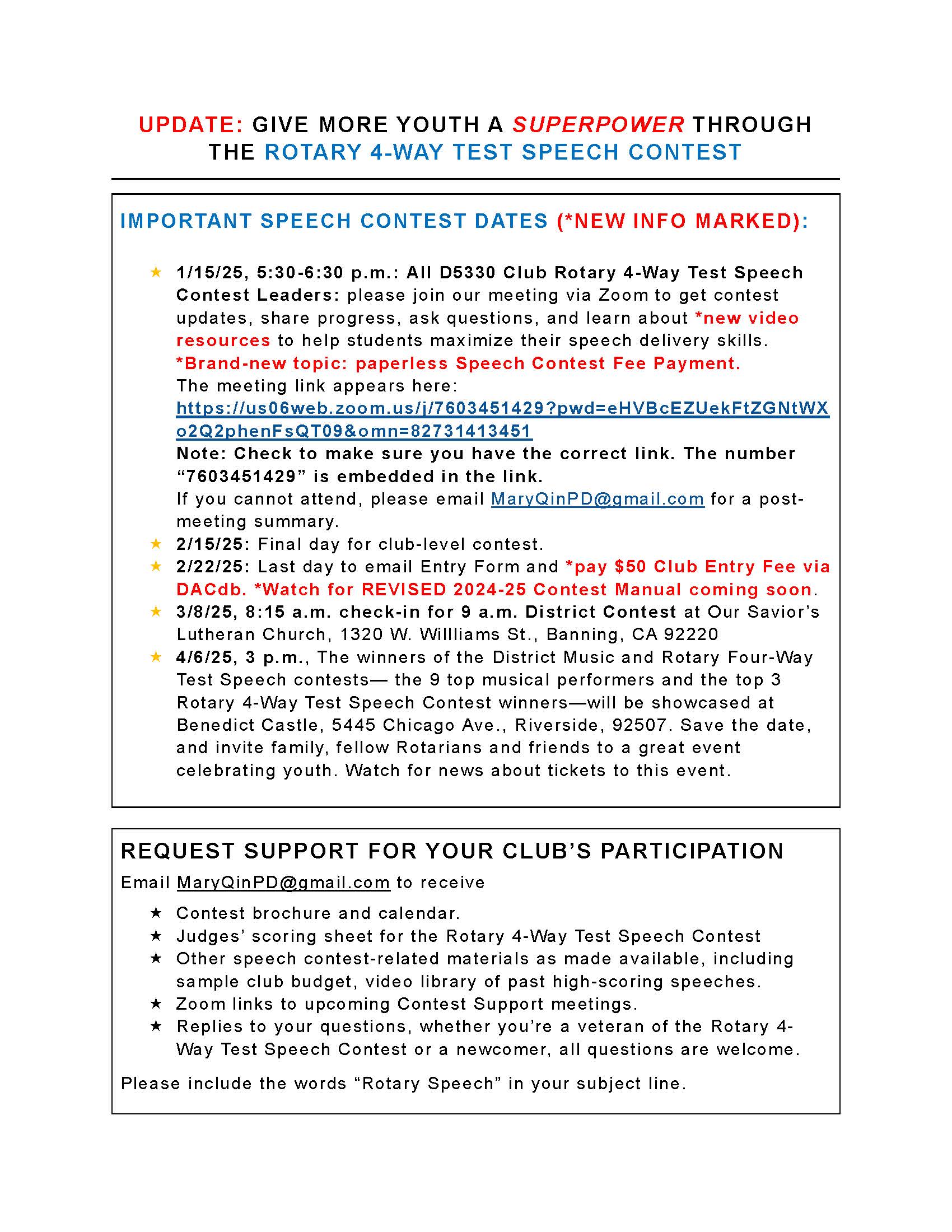
DISCOVER MORE

Rotary Global Grant – Dominican Republic Project Trip

February 2025 – Community Service
Limiting Vulnerability With Community Service
With the recent fires here in SoCal it is pretty evident that disasters for some create opportunities.
Every club in our district has specific areas that are both very susceptible to fires when things get dry, as well as elderly that are unable to physically or financially attack the necessary abatement that their property desperately needs.
What a great opportunity clubs have to create a new category of community service on a monthly ongoing basis.
Helping to assist or handle abatement against fires is something that only takes a group of people once a month to make a huge difference. Just think if our clubs had two groups : a “weekend abatement” and “weekday abatement” group to attack much needed help in our communities. Many fire departments can let us know areas that we can go out and perform fire abatement getting rid of dead undergrowth, weeds and the like in our communities. As a matter of fact, some fire departments will work with groups that contact them asking for locations the club can help abate.
Low income areas with senior citizens that are not physically able to perform or pay to to abate are great targets for assistance. Senior centers are a great place to ask around as are mobile home parks. It’s amazing what can be done and who can be helped in advance of a catastrophe that can make a huge difference and even impact saving lives. Many clubs have retirees that can form a phone chain to get out there and help during the work week and all clubs have professionals that can help one weekend a month being set up via another phone chain. We all know that working together with our fellow members is a strong glue that makes our clubs and friendships stronger. Why not create “Pizza and Pick Weeds” events? (What members can turn down a pizza?)
We are Rotary, let’s help get ahead of issues whenever we can: it’s fun, it’s productive and our visual appearance out in the community is a great way to also attract and recruit new members.
Chuck Weisbart (Cheeze)
Proudly- an Idyllwild Rotarian!
D5330 Community Service Chair
760 578 3592
P.O.Box 278, Idyllwild CA 92549
February 2025 – Vocational Service
Happy New Year to all the Rotarians in D5330! The past 6 months have flown by! Now we are coming down to the last 5 months of this Rotary year and DGE Nyron’s Pre-PETS and DG Judy’s Mid-Year Review were tremendously successful last month! Both were held at Crafton Hills College on January 18th. Much was learned by all of the participants.
Now it’s time to focus on the upcoming District Training Assembly on Saturday, April 19th again at Tahquitz HS in Hemet. I will be conducting a session on the 5 Avenues of Service with emphasis, of course, on Vocational Service. There will be others speaking specifically on International and Community Service, as well. Please join us!
As I have mentioned in previous articles here on the district’s blog, I would love for all of the clubs in the district to nominate an Outstanding Business or Profession that has greatly benefitted your community this past Rotary year. The Rotary Award for Vocational Excellence (R.A.V.E.) will be given out at DG Judy’s District Conference in May. The deadline for your submission is March 15. The application is in this blog. While you complete the form, please detail how your nominee has benefitted your immediate community. I would like you to be as informative as possible about your nominee when filling out the form. My e-mail to send it back to me is: [email protected]
I look forward to receiving your completed applications before the deadline date so our committee may evaluate each and every one of the nominees.
Thank you and Good Luck!
Bill Chase, PDG
Chair, D5330 Vocational Service Committee

February – 4 Way Test Speech Contest
February 2025 – Corona Golf Tournament
Pollinators: The Little Things That Move the World
Jack Fitzsimmons
Rotary Club of Palm Desert
“Do you like to eat?”
Ask that question of a classroom full of third graders and you can imagine the response! I ask a second question: “Do you like to eat apples, or pumpkin pie, or watermelon?” Enthusiastic hands shoot up in the air. And then a final question, “Who helped make that apple that you eat?” Shouted responses include “Mommy! Abuela! Albertson’s!” You can hear a pin drop when I say, “That apple actually starts with a bee!” Thus begins the students first introduction to pollination.
So, what on earth does pollination have to do with Rotary? Quite a lot, it turns out.
On June 25, 2020, Rotary President Mark Maloney announced Protecting the Environment as our Seventh Area of Focus. Of course, Rotarians have been involved for decades with projects involving the environment. It many cases, the health of the environment is inseparable from issues of maternal health, water and hygiene, community building, and increasingly, peacebuilding. According to a World Bank estimates, by 2050 as many as 216 million people could be internally displaced by climate change. Tragically, the impact of a changing climate, compounded by habitat loss, pesticide misuse, and plant disease, is hitting our pollinators. Hard. Decline in pollinators varies according to species, but losses have exceeded 40% in the last decade – with no end in sight.
Consider the apple again. Most people are not aware that one out of every three bites of food we eat depend on pollinators. Some crops, like almonds, are entirely dependent on pollinators. In fact, 85% of the plants on Mother Earth depend on pollinators. With our food security facing an existential crisis of such magnitude, what can we do? Plenty!
People of Action Step Up
The first Operation Pollination (OP) project was launched in August 2015 in the St. Croix Valley of Minnesota and Wisconsin. A group of concerned citizens organized to collectively address the issue of pollinator loss and began restoring and creating pollinator habitats in their backyards, city parks, and schoolyards.
The organization blossomed and on September 24, 2022, the Environmental Sustainability Rotary Action Group (ESRAG), a division of Rotary International, and its Pollinator Task Group organized the signing of a multitude of pollinator partnership resolutions between Rotary districts and National Heritage Areas and other partners throughout the US, Canada and Mexico. This historic signing was done in coordination with the whistle-stop campaign of Rotary International’s first female president, Jennifer Jones.
Today, OP has 253 signed Pollinator Resolutions with Rotary Districts, individual clubs, water agencies, municipalities, and non-profit organizations. There are currently 175 OP “ambassadors” on six continents who have been trained to act as a catalyst for engagement and education. I have the great fortune to be one of the most recent ambassadors.
On December 27, 2024, District 5330 Governor Judy Zulfiqar signed the Pollinator Resolution. The Resolution is simple: it acknowledges the critical importance of pollinators and the crisis that we are facing, and that the leadership and impact of Rotarians volunteering to improve communities is a hallmark of Rotary International.
It is important to note that ESRAG’s Operation Pollination is a truly inclusive framework that helps recruit a diverse array of organizational partners willing to engage in the framework’s two goals: pollinator habitat restoration and education projects. Anyone can join; you do not have to be a Rotarian.
Personal Action
You can help pollinators at a personal level by a few simple steps:
- Plant a pollinator garden in your window box, patio, or backyard. Use native plants as much as possible because some pollinators won’t visit the “foreign” exotics that you find in nursery centers and big box stores, leading to a further loss of pollen and nectar food for local species.
- Provide nesting materials such as a small pile of brush or a hollow bamboo or yucca stem. Provide a shallow dish of water and most importantly, leave some of the soil of your yard or potted plants bare. Many of the local pollinator species nest in the ground.
- Eliminate the use of pesticides wherever possible since they poison both harmful and beneficial insects – and us!
- Learn about and get involved with the many like-minded organizations in your area – garden clubs, butterfly networks, native plant societies, and botanical and demonstration gardens.
- Buy organic produce from small local farms who use sustainable pollinator practices.
Club Action
On their websites, ESRAG and Operation Pollination offer a comprehensive Project Planning Toolkit and numerous examples of pollinator projects. These can range from establishing a pollinator demonstration at a local grade school, church or assisted living facility and sponsoring native plant sales and seed swaps, to advocating for open space and responsible land management at local government agencies. At a larger scale, there have been District and multi-district efforts to create pollinator garden “pathways” across state and country borders to support Monarch butterfly migration. And in Europe, there is a four-country project that gave away flowering plants to improve declining honey production. The project even collected and sold honey to enable the project’s sustainability. Large or small, there is nothing that People of Action cannot accomplish.
Want to know more?
Watch this short video produced by Operation Pollination and this interview with Past President Jennifer Jones. You can always contact me at [email protected] if for further information about Operation Pollination.

February 2025 – Palm Desert
Pollinators: The Little Things That Move the World
Jack Fitzsimmons
Rotary Club of Palm Desert
“Do you like to eat?”
Ask that question of a classroom full of third graders and you can imagine the response! I ask a second question: “Do you like to eat apples, or pumpkin pie, or watermelon?” Enthusiastic hands shoot up in the air. And then a final question, “Who helped make that apple that you eat?” Shouted responses include “Mommy! Abuela! Albertson’s!” You can hear a pin drop when I say, “That apple actually starts with a bee!” Thus begins the students first introduction to pollination.
So, what on earth does pollination have to do with Rotary? Quite a lot, it turns out.
On June 25, 2020, Rotary President Mark Maloney announced Protecting the Environment as our Seventh Area of Focus. Of course, Rotarians have been involved for decades with projects involving the environment. It many cases, the health of the environment is inseparable from issues of maternal health, water and hygiene, community building, and increasingly, peacebuilding. According to a World Bank estimates, by 2050 as many as 216 million people could be internally displaced by climate change. Tragically, the impact of a changing climate, compounded by habitat loss, pesticide misuse, and plant disease, is hitting our pollinators. Hard. Decline in pollinators varies according to species, but losses have exceeded 40% in the last decade – with no end in sight.
Consider the apple again. Most people are not aware that one out of every three bites of food we eat depend on pollinators. Some crops, like almonds, are entirely dependent on pollinators. In fact, 85% of the plants on Mother Earth depend on pollinators. With our food security facing an existential crisis of such magnitude, what can we do? Plenty!
People of Action Step Up
The first Operation Pollination (OP) project was launched in August 2015 in the St. Croix Valley of Minnesota and Wisconsin. A group of concerned citizens organized to collectively address the issue of pollinator loss and began restoring and creating pollinator habitats in their backyards, city parks, and schoolyards.
The organization blossomed and on September 24, 2022, the Environmental Sustainability Rotary Action Group (ESRAG), a division of Rotary International, and its Pollinator Task Group organized the signing of a multitude of pollinator partnership resolutions between Rotary districts and National Heritage Areas and other partners throughout the US, Canada and Mexico. This historic signing was done in coordination with the whistle-stop campaign of Rotary International’s first female president, Jennifer Jones.
Today, OP has 253 signed Pollinator Resolutions with Rotary Districts, individual clubs, water agencies, municipalities, and non-profit organizations. There are currently 175 OP “ambassadors” on six continents who have been trained to act as a catalyst for engagement and education. I have the great fortune to be one of the most recent ambassadors.
On December 27, 2024, District 5330 Governor Judy Zulfiqar signed the Pollinator Resolution. The Resolution is simple: it acknowledges the critical importance of pollinators and the crisis that we are facing, and that the leadership and impact of Rotarians volunteering to improve communities is a hallmark of Rotary International.
It is important to note that ESRAG’s Operation Pollination is a truly inclusive framework that helps recruit a diverse array of organizational partners willing to engage in the framework’s two goals: pollinator habitat restoration and education projects. Anyone can join; you do not have to be a Rotarian.
Personal Action
You can help pollinators at a personal level by a few simple steps:
- Plant a pollinator garden in your window box, patio, or backyard. Use native plants as much as possible because some pollinators won’t visit the “foreign” exotics that you find in nursery centers and big box stores, leading to a further loss of pollen and nectar food for local species.
- Provide nesting materials such as a small pile of brush or a hollow bamboo or yucca stem. Provide a shallow dish of water and most importantly, leave some of the soil of your yard or potted plants bare. Many of the local pollinator species nest in the ground.
- Eliminate the use of pesticides wherever possible since they poison both harmful and beneficial insects – and us!
- Learn about and get involved with the many like-minded organizations in your area – garden clubs, butterfly networks, native plant societies, and botanical and demonstration gardens.
- Buy organic produce from small local farms who use sustainable pollinator practices.
Club Action
On their websites, ESRAG and Operation Pollination offer a comprehensive Project Planning Toolkit and numerous examples of pollinator projects. These can range from establishing a pollinator demonstration at a local grade school, church or assisted living facility and sponsoring native plant sales and seed swaps, to advocating for open space and responsible land management at local government agencies. At a larger scale, there have been District and multi-district efforts to create pollinator garden “pathways” across state and country borders to support Monarch butterfly migration. And in Europe, there is a four-country project that gave away flowering plants to improve declining honey production. The project even collected and sold honey to enable the project’s sustainability. Large or small, there is nothing that People of Action cannot accomplish.
Want to know more?
Watch this short video produced by Operation Pollination and this interview with Past President Jennifer Jones. You can always contact me at [email protected] if for further information about Operation Pollination.

February 2025 – Polio Plus
2025 February – DEI

THE PAUL HARRIS WAY
Classifications. Remember those? Virtually all membership in Rotary was based upon a “classification” that described the distinct and recognized business or professional service that the Rotarian renders to society. Rotary International ended required classification designations a few years ago, and many clubs no longer require that either.
How diverse are the business classifications in your club? Does your Rotary club represent a cross section of the business and professional service of your community. Does your club have a member directory identifying members’ businesses so that members can patronize them?
Diversity is also about recognizing, respecting and valuing differences in our members and in our communities.
Setting aside the divisive discussions on diversity, consider it in the context of business classifications and how a wide variety of classifications benefits your club. Paul Harris found Rotary on the premise that Diversity is also about recognizing, respecting and valuing differences based on people of good will and diverse backgrounds should come together in the spirit of friendship to foster better understanding. He believed that clubs should represent and embrace the diversity in their communities.
January 2025 – Club Event Temecula Sunrise

January 2025 – 4 Way Speech Test

KEY LITERACY CATEGORIES

We have a very active District when it comes to literacy.
The following is a list of project ideas collected from the Literacy Award applications received over the past several years. Ideas for you to consider fall into three general categories: Club Literacy, Funding Focused, Front-line Literacy
Literacy projects that take place within your club
Devote a club meeting to planning literacy projects.
Host a speaker at a club meeting from Success By Six to speak about children’s literacy.
Reference “The Rotarian” magazine at club meetings and encourage members to read it.
Host a speaker from your school district/adult education program to speak about numeracy.
Include information and links on the importance of reading with children on your club website.
Appoint a “literacy chair” on your board of directors.
Host a literacy workshop for members.
Create a limerick writing contest within the club or between two clubs.
Bring in an author as a guest speaker
Share favorite books, poems, magazine or websites at meetings.
Host a presentation on tutoring and reading with children for members.
Conduct a monthly or bi-monthly reading group among Rotary members, friends, family, school district and First Nations.
Where your club funds a literacy project
Support local school libraries of all levels with book donations which can include bookplates identifying the Rotary.
Provide schools with identified needed reading resources. i.e.- online leveled reading programs for specific grades.
Donate large print books to seniors home.
Fund the creation of a cultural learning DVD for local First Nations group.
Donate to local literacy program like Literacy Now- Books for Babies Program or Born to Read.
Donate to a specific program at the public library such as Teen Advisory Committee or the Adult Reading Program.
Provide literacy supportive equipment identified by a school’s “wish list” such as a document camera and LCD projector.
Support a community program such as the Head Start Read and Play Group and Longview Stageworks After School Theatre Club.
Donate to a local schools lunch program which aims to deal with hunger as a learning inhibitor.
Help fund your local literacy bus.
Donate school supplies.
Sponsor prizes for an essay contest for middle school students in grades 6-8.
Contribute to a school summer reading program- books given to each child to encourage continued reading.
Support school and community music programs.
Buy specialized laptops for students with communication challenges.
Sponsor students to attend Rotary Programs- e.g. Adventures in Technology.
Sponsor Missoula Children s Theatre for local school or community programs.
Support or manage the construction of a library or learning centre locally or abroad.
Donate to Success By Six or Early Start.
Participate in an international book shipping project.
Help fund an international mini-library project.
Where your club volunteers in a literacy capacity
Volunteer in an elementary school library that might be otherwise closed due to budget. Check in/out materials, conduct story times you could also give homework help to students.
Organize and participate in a one-day event of listening to students read their stories about their heroes.
Celebrate Dr. Seuss, one-day event – visit 20 classrooms, dress in red and white striped hats and donate a book to each class.
Host students from an adopted school to sing songs and perform.
Partner with other programs e.g. “Read to Me” and volunteer your time to them.
Conduct story times at local events such as a children’s festival.
Volunteer once a week at a school to read with students.
Donate gently used adult books for Christmas hampers for local families.
Participate in a book or coloring book drive to support non-profit children’s organizations.
Participate in education workshops for kids at the Boys and Girls Club.
Attend or organize a school field trip and have Rotarians buddy with elementary school children to familiarize them with the public library.
Develop a literacy roundtable in the community where a member from each club attends and focuses on supporting literacy in partnership with other clubs – and on their own.
Provide books for a school to use a positive reinforcement reward for their students.
Donate materials to support a classroom in need- e.g. a math game – and volunteer to play with kindergarten students needing to develop numeracy skills.
Participate in newspaper sale for “Raise A Reader”
Collect books for community bookstore to celebrate Literacy Day.
Create a literacy float in a community parade.
Donate literacy boxes to local women’s centre and transition houses filled with children/adult books.
Donate books to local correctional centre.
Fundraise with your local literacy society.
Host a public library literacy night.
Host a holiday breakfast and book giveaway.
LITERACY RESOURCES

Rotary Global Grant – Dominican Republic Project Trip

February 2025 – Community Service
Limiting Vulnerability With Community Service
With the recent fires here in SoCal it is pretty evident that disasters for some create opportunities.
Every club in our district has specific areas that are both very susceptible to fires when things get dry, as well as elderly that are unable to physically or financially attack the necessary abatement that their property desperately needs.
What a great opportunity clubs have to create a new category of community service on a monthly ongoing basis.
Helping to assist or handle abatement against fires is something that only takes a group of people once a month to make a huge difference. Just think if our clubs had two groups : a “weekend abatement” and “weekday abatement” group to attack much needed help in our communities. Many fire departments can let us know areas that we can go out and perform fire abatement getting rid of dead undergrowth, weeds and the like in our communities. As a matter of fact, some fire departments will work with groups that contact them asking for locations the club can help abate.
Low income areas with senior citizens that are not physically able to perform or pay to to abate are great targets for assistance. Senior centers are a great place to ask around as are mobile home parks. It’s amazing what can be done and who can be helped in advance of a catastrophe that can make a huge difference and even impact saving lives. Many clubs have retirees that can form a phone chain to get out there and help during the work week and all clubs have professionals that can help one weekend a month being set up via another phone chain. We all know that working together with our fellow members is a strong glue that makes our clubs and friendships stronger. Why not create “Pizza and Pick Weeds” events? (What members can turn down a pizza?)
We are Rotary, let’s help get ahead of issues whenever we can: it’s fun, it’s productive and our visual appearance out in the community is a great way to also attract and recruit new members.
Chuck Weisbart (Cheeze)
Proudly- an Idyllwild Rotarian!
D5330 Community Service Chair
760 578 3592
P.O.Box 278, Idyllwild CA 92549
February 2025 – Vocational Service
Happy New Year to all the Rotarians in D5330! The past 6 months have flown by! Now we are coming down to the last 5 months of this Rotary year and DGE Nyron’s Pre-PETS and DG Judy’s Mid-Year Review were tremendously successful last month! Both were held at Crafton Hills College on January 18th. Much was learned by all of the participants.
Now it’s time to focus on the upcoming District Training Assembly on Saturday, April 19th again at Tahquitz HS in Hemet. I will be conducting a session on the 5 Avenues of Service with emphasis, of course, on Vocational Service. There will be others speaking specifically on International and Community Service, as well. Please join us!
As I have mentioned in previous articles here on the district’s blog, I would love for all of the clubs in the district to nominate an Outstanding Business or Profession that has greatly benefitted your community this past Rotary year. The Rotary Award for Vocational Excellence (R.A.V.E.) will be given out at DG Judy’s District Conference in May. The deadline for your submission is March 15. The application is in this blog. While you complete the form, please detail how your nominee has benefitted your immediate community. I would like you to be as informative as possible about your nominee when filling out the form. My e-mail to send it back to me is: [email protected]
I look forward to receiving your completed applications before the deadline date so our committee may evaluate each and every one of the nominees.
Thank you and Good Luck!
Bill Chase, PDG
Chair, D5330 Vocational Service Committee

February – 4 Way Test Speech Contest
February 2025 – Corona Golf Tournament
Pollinators: The Little Things That Move the World
Jack Fitzsimmons
Rotary Club of Palm Desert
“Do you like to eat?”
Ask that question of a classroom full of third graders and you can imagine the response! I ask a second question: “Do you like to eat apples, or pumpkin pie, or watermelon?” Enthusiastic hands shoot up in the air. And then a final question, “Who helped make that apple that you eat?” Shouted responses include “Mommy! Abuela! Albertson’s!” You can hear a pin drop when I say, “That apple actually starts with a bee!” Thus begins the students first introduction to pollination.
So, what on earth does pollination have to do with Rotary? Quite a lot, it turns out.
On June 25, 2020, Rotary President Mark Maloney announced Protecting the Environment as our Seventh Area of Focus. Of course, Rotarians have been involved for decades with projects involving the environment. It many cases, the health of the environment is inseparable from issues of maternal health, water and hygiene, community building, and increasingly, peacebuilding. According to a World Bank estimates, by 2050 as many as 216 million people could be internally displaced by climate change. Tragically, the impact of a changing climate, compounded by habitat loss, pesticide misuse, and plant disease, is hitting our pollinators. Hard. Decline in pollinators varies according to species, but losses have exceeded 40% in the last decade – with no end in sight.
Consider the apple again. Most people are not aware that one out of every three bites of food we eat depend on pollinators. Some crops, like almonds, are entirely dependent on pollinators. In fact, 85% of the plants on Mother Earth depend on pollinators. With our food security facing an existential crisis of such magnitude, what can we do? Plenty!
People of Action Step Up
The first Operation Pollination (OP) project was launched in August 2015 in the St. Croix Valley of Minnesota and Wisconsin. A group of concerned citizens organized to collectively address the issue of pollinator loss and began restoring and creating pollinator habitats in their backyards, city parks, and schoolyards.
The organization blossomed and on September 24, 2022, the Environmental Sustainability Rotary Action Group (ESRAG), a division of Rotary International, and its Pollinator Task Group organized the signing of a multitude of pollinator partnership resolutions between Rotary districts and National Heritage Areas and other partners throughout the US, Canada and Mexico. This historic signing was done in coordination with the whistle-stop campaign of Rotary International’s first female president, Jennifer Jones.
Today, OP has 253 signed Pollinator Resolutions with Rotary Districts, individual clubs, water agencies, municipalities, and non-profit organizations. There are currently 175 OP “ambassadors” on six continents who have been trained to act as a catalyst for engagement and education. I have the great fortune to be one of the most recent ambassadors.
On December 27, 2024, District 5330 Governor Judy Zulfiqar signed the Pollinator Resolution. The Resolution is simple: it acknowledges the critical importance of pollinators and the crisis that we are facing, and that the leadership and impact of Rotarians volunteering to improve communities is a hallmark of Rotary International.
It is important to note that ESRAG’s Operation Pollination is a truly inclusive framework that helps recruit a diverse array of organizational partners willing to engage in the framework’s two goals: pollinator habitat restoration and education projects. Anyone can join; you do not have to be a Rotarian.
Personal Action
You can help pollinators at a personal level by a few simple steps:
- Plant a pollinator garden in your window box, patio, or backyard. Use native plants as much as possible because some pollinators won’t visit the “foreign” exotics that you find in nursery centers and big box stores, leading to a further loss of pollen and nectar food for local species.
- Provide nesting materials such as a small pile of brush or a hollow bamboo or yucca stem. Provide a shallow dish of water and most importantly, leave some of the soil of your yard or potted plants bare. Many of the local pollinator species nest in the ground.
- Eliminate the use of pesticides wherever possible since they poison both harmful and beneficial insects – and us!
- Learn about and get involved with the many like-minded organizations in your area – garden clubs, butterfly networks, native plant societies, and botanical and demonstration gardens.
- Buy organic produce from small local farms who use sustainable pollinator practices.
Club Action
On their websites, ESRAG and Operation Pollination offer a comprehensive Project Planning Toolkit and numerous examples of pollinator projects. These can range from establishing a pollinator demonstration at a local grade school, church or assisted living facility and sponsoring native plant sales and seed swaps, to advocating for open space and responsible land management at local government agencies. At a larger scale, there have been District and multi-district efforts to create pollinator garden “pathways” across state and country borders to support Monarch butterfly migration. And in Europe, there is a four-country project that gave away flowering plants to improve declining honey production. The project even collected and sold honey to enable the project’s sustainability. Large or small, there is nothing that People of Action cannot accomplish.
Want to know more?
Watch this short video produced by Operation Pollination and this interview with Past President Jennifer Jones. You can always contact me at [email protected] if for further information about Operation Pollination.

February 2025 – Palm Desert
Pollinators: The Little Things That Move the World
Jack Fitzsimmons
Rotary Club of Palm Desert
“Do you like to eat?”
Ask that question of a classroom full of third graders and you can imagine the response! I ask a second question: “Do you like to eat apples, or pumpkin pie, or watermelon?” Enthusiastic hands shoot up in the air. And then a final question, “Who helped make that apple that you eat?” Shouted responses include “Mommy! Abuela! Albertson’s!” You can hear a pin drop when I say, “That apple actually starts with a bee!” Thus begins the students first introduction to pollination.
So, what on earth does pollination have to do with Rotary? Quite a lot, it turns out.
On June 25, 2020, Rotary President Mark Maloney announced Protecting the Environment as our Seventh Area of Focus. Of course, Rotarians have been involved for decades with projects involving the environment. It many cases, the health of the environment is inseparable from issues of maternal health, water and hygiene, community building, and increasingly, peacebuilding. According to a World Bank estimates, by 2050 as many as 216 million people could be internally displaced by climate change. Tragically, the impact of a changing climate, compounded by habitat loss, pesticide misuse, and plant disease, is hitting our pollinators. Hard. Decline in pollinators varies according to species, but losses have exceeded 40% in the last decade – with no end in sight.
Consider the apple again. Most people are not aware that one out of every three bites of food we eat depend on pollinators. Some crops, like almonds, are entirely dependent on pollinators. In fact, 85% of the plants on Mother Earth depend on pollinators. With our food security facing an existential crisis of such magnitude, what can we do? Plenty!
People of Action Step Up
The first Operation Pollination (OP) project was launched in August 2015 in the St. Croix Valley of Minnesota and Wisconsin. A group of concerned citizens organized to collectively address the issue of pollinator loss and began restoring and creating pollinator habitats in their backyards, city parks, and schoolyards.
The organization blossomed and on September 24, 2022, the Environmental Sustainability Rotary Action Group (ESRAG), a division of Rotary International, and its Pollinator Task Group organized the signing of a multitude of pollinator partnership resolutions between Rotary districts and National Heritage Areas and other partners throughout the US, Canada and Mexico. This historic signing was done in coordination with the whistle-stop campaign of Rotary International’s first female president, Jennifer Jones.
Today, OP has 253 signed Pollinator Resolutions with Rotary Districts, individual clubs, water agencies, municipalities, and non-profit organizations. There are currently 175 OP “ambassadors” on six continents who have been trained to act as a catalyst for engagement and education. I have the great fortune to be one of the most recent ambassadors.
On December 27, 2024, District 5330 Governor Judy Zulfiqar signed the Pollinator Resolution. The Resolution is simple: it acknowledges the critical importance of pollinators and the crisis that we are facing, and that the leadership and impact of Rotarians volunteering to improve communities is a hallmark of Rotary International.
It is important to note that ESRAG’s Operation Pollination is a truly inclusive framework that helps recruit a diverse array of organizational partners willing to engage in the framework’s two goals: pollinator habitat restoration and education projects. Anyone can join; you do not have to be a Rotarian.
Personal Action
You can help pollinators at a personal level by a few simple steps:
- Plant a pollinator garden in your window box, patio, or backyard. Use native plants as much as possible because some pollinators won’t visit the “foreign” exotics that you find in nursery centers and big box stores, leading to a further loss of pollen and nectar food for local species.
- Provide nesting materials such as a small pile of brush or a hollow bamboo or yucca stem. Provide a shallow dish of water and most importantly, leave some of the soil of your yard or potted plants bare. Many of the local pollinator species nest in the ground.
- Eliminate the use of pesticides wherever possible since they poison both harmful and beneficial insects – and us!
- Learn about and get involved with the many like-minded organizations in your area – garden clubs, butterfly networks, native plant societies, and botanical and demonstration gardens.
- Buy organic produce from small local farms who use sustainable pollinator practices.
Club Action
On their websites, ESRAG and Operation Pollination offer a comprehensive Project Planning Toolkit and numerous examples of pollinator projects. These can range from establishing a pollinator demonstration at a local grade school, church or assisted living facility and sponsoring native plant sales and seed swaps, to advocating for open space and responsible land management at local government agencies. At a larger scale, there have been District and multi-district efforts to create pollinator garden “pathways” across state and country borders to support Monarch butterfly migration. And in Europe, there is a four-country project that gave away flowering plants to improve declining honey production. The project even collected and sold honey to enable the project’s sustainability. Large or small, there is nothing that People of Action cannot accomplish.
Want to know more?
Watch this short video produced by Operation Pollination and this interview with Past President Jennifer Jones. You can always contact me at [email protected] if for further information about Operation Pollination.

February 2025 – Polio Plus
2025 February – DEI

THE PAUL HARRIS WAY
Classifications. Remember those? Virtually all membership in Rotary was based upon a “classification” that described the distinct and recognized business or professional service that the Rotarian renders to society. Rotary International ended required classification designations a few years ago, and many clubs no longer require that either.
How diverse are the business classifications in your club? Does your Rotary club represent a cross section of the business and professional service of your community. Does your club have a member directory identifying members’ businesses so that members can patronize them?
Diversity is also about recognizing, respecting and valuing differences in our members and in our communities.
Setting aside the divisive discussions on diversity, consider it in the context of business classifications and how a wide variety of classifications benefits your club. Paul Harris found Rotary on the premise that Diversity is also about recognizing, respecting and valuing differences based on people of good will and diverse backgrounds should come together in the spirit of friendship to foster better understanding. He believed that clubs should represent and embrace the diversity in their communities.
January 2025 – Club Event Temecula Sunrise

January 2025 – 4 Way Speech Test

